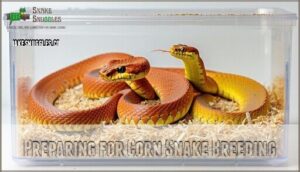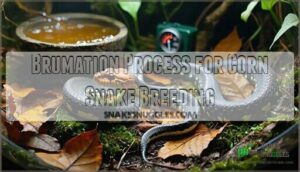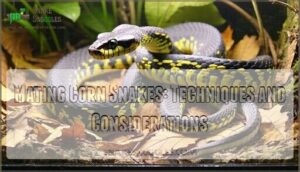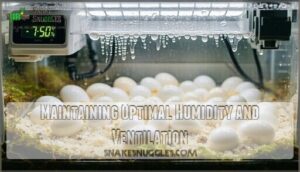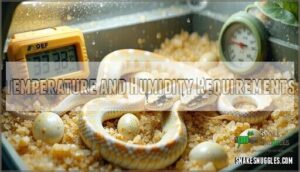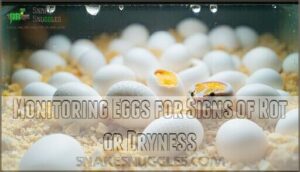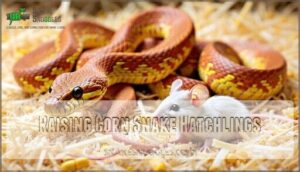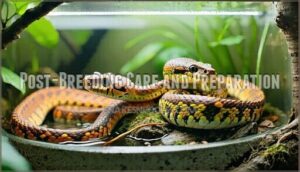This site is supported by our readers. We may earn a commission, at no cost to you, if you purchase through links.
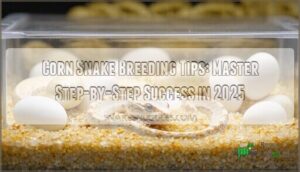
Prepare by cooling your snakes gradually to 55-60°F for 2-3 months during winter (brumation).
After warming them back up, place males with females when you notice increased activity.
Female corn snakes lay 10-30 eggs about 30-45 days after mating.
Incubate eggs at 82°F with 80-90% humidity in vermiculite or perlite.
Eggs typically hatch in 60 days.
Genetics play a vital role in determining offspring appearance, with certain morphs requiring special consideration to avoid health issues, and this is crucial for successful breeding, considering the importance of genetics.
Table Of Contents
- Key Takeaways
- Preparing for Corn Snake Breeding
- Understanding Corn Snake Genetics
- Brumation Process for Corn Snake Breeding
- Mating Corn Snakes: Techniques and Considerations
- Caring for Gravid Corn Snakes
- Preparing for Egg-Laying and Incubation
- Incubating Corn Snake Eggs
- Caring for Newborn Corn Snakes
- Raising Corn Snake Hatchlings
- Post-Breeding Care and Preparation
- Frequently Asked Questions (FAQs)
- Are corn snakes easy to breed?
- How long does it take to breed corn snakes?
- What is the mating ritual of corn snakes?
- How to breed corn snakes?
- How do I know if my corn snake is ready to breed?
- What if corn snakes don’t breed?
- How do you raise corn snakes?
- What is the Best Way to Sex a Corn Snake?
- How Often Should I Feed Adult Corn Snakes?
- Are There Any Special Incubation Requirements for Corn Snake Eggs?
- Conclusion
Key Takeaways
- You’ll need healthy adult corn snakes at least 2-3 years old weighing over 300 grams, with proper brumation (cooling to 55-60°F for 2-3 months) to prepare them for successful breeding.
- When breeding, watch for signs of female receptiveness like recent shedding, body swelling, and nesting behavior before introducing the male, then monitor your gravid female’s nutrition and environment carefully.
- You’ll need to maintain corn snake eggs at 80-84°F with 75-80% humidity in a proper incubation medium, checking regularly for signs of mold or drying for approximately 60 days until hatching.
- Your hatchlings require appropriate housing with temperature gradients, regular feeding of pinky mice after their first shed, and gentle handling to socialize them for healthy development and successful breeding.
Preparing for Corn Snake Breeding
To prepare for corn snake breeding, start by selecting healthy, mature snakes that meet age and weight requirements.
Make certain proper housing, avoid inbreeding, and research the local market to plan for the offspring.
Choosing Healthy Corn Snakes
When selecting corn snakes for breeding, start with a visual assessment to check for clear eyes, smooth scales, and proper body weight.
Perform temperament screening and review their genetic history to guarantee genetic health.
Quarantine new snakes and schedule a veterinary examination to rule out parasites.
Healthy, mature snake selection guarantees strong genetic diversity and promising breeding outcomes. Prioritize corn snake genetics for success.
Avoiding Inbreeding and Cross-Breeding
Maintaining genetic diversity is key to ethical breeding and healthy offspring.
To avoid inbreeding, choose snakes from unrelated lineages and trace genetic history carefully. Use responsible outcrossing for morph compatibility and hybrid vigor, ensuring ethical practices.
Pairing without lineage tracking can risk genetic issues like deformities or health problems.
- Tips for Avoiding Inbreeding:
- Source snakes from distinct bloodlines.
- Use detailed genetic lineage records.
- Avoid pairing closely related snakes.
- Consult experienced breeders for advice.
- Verify morph compatibility for healthier offspring.
Researching Local Snake Market
Understanding your local snake market guarantees your hatchlings find homes easily.
Research market demand, competition, and pricing to avoid oversupplying.
- Check pricing strategies and trends to stay competitive.
- Study legal regulations to navigate breeding rules.
- Partner with ethical breeders to maintain industry standards.
Knowing which corn snake morphs are popular helps align your breeding plans.
Effective market research prevents waste and boosts your breeding success.
Before breeding, remember to conduct a thorough health assessment to guarantee the snakes are fit.
Understanding Corn Snake Genetics
Understanding corn snake genetics helps you predict offspring color and pattern combinations, ensuring desirable traits. Focus on pairing compatible morphs to avoid health issues linked to specific genetic mutations.
Genetic Considerations for Breeding Pairs
Before breeding, focus on lineage tracking to strengthen corn snake genetics. Prioritize genetic screening to avoid inbreeding and guarantee genetic health.
Understand trait inheritance for creating stunning corn snake morphs, especially involving recessive genes. Aim for genetic diversity by pairing compatible morphs while avoiding harmful traits.
Smart morph compatibility choices prevent health issues and guarantee productive outcomes, ensuring vibrant, healthy clutches that reflect responsible breeding practices. Maintaining proper humidity levels post-egg laying is also critical.
Health Risks Associated With Specific Morphs
When breeding corn snake morphs, watch for morph-linked diseases and health risks tied to genetic mutations.
For example:
- Lavender morphs: Higher deformity prevalence, like spinal kinks, worsens with warmer incubation.
- Palmetto morphs: Known for bug eyes, though non-harmful.
Responsible breeding reduces genetic defects.
Selective pairing and avoiding deformity-prone morphs guarantee healthier hatchlings.
Always prioritize selective breeding to curb genetic issues.
Brumation Process for Corn Snake Breeding
Brumation is a critical step in preparing your corn snakes for breeding, mimicking their natural winter dormancy.
By gradually lowering temperature and light levels, you’ll promote fertility while ensuring their health remains stable.
Gradual Temperature and Light Reduction
To kickstart brumation, mimic nature with seasonal simulation. Gradually lower the light spectrum and temperature over 2-4 weeks to ease your snake into this cooler rest period.
Aim for a steady temperature gradient, reducing to the ideal hibernation temperature of 55°F (13°C). This slow temperature reduction and light reduction signals your snake it’s time to rest, setting the stage for a healthy breeding season.
Using a reptile light timer can help automate this process.
Optimal Brumation Duration and Conditions
Corn snake brumation lasts 60-75 days, mimicking their natural cycle.
Gradually reduce temperature to 50°F-60°F with steady humidity to prevent dehydration. Guarantee fresh air for ideal conditions.
- Important Tips:
- Keep brumation temperature between 50°F-60°F.
- Maintain brumation humidity levels to avoid shedding issues.
- Provide water access throughout brumation to guarantee hydration.
These steps promote healthy hibernation and breeding success.
Monitoring Snake Health During Brumation
During brumation, monitor snake health closely, keeping an eye out for weight loss, hydration levels, respiratory issues, or changes in skin condition.
Check behavior regularly, as problems can hide during this period, and verify temperature control and stable humidity levels.
A quick inspection every week guarantees proper brumation duration while keeping your corn snake healthy and stress-free throughout the process.
Mating Corn Snakes: Techniques and Considerations
Pairing corn snakes for breeding requires careful timing, proper introductions, and observation of natural behaviors.
By watching for signs like female receptiveness and male courtship, you can create the ideal conditions for successful mating, which involves understanding and responding to signs like receptiveness.
Introducing Male and Female Corn Snakes
Introducing your male and female corn snakes? It’s all about thoughtful planning.
Verify they’re healthy, mature, and ready for mating. Supervise every interaction to guarantee stress-free behavior. Success often depends on compatibility and preparation.
- Spacious enclosure to reduce tension.
- Male dominance behaviors should be observed carefully.
- Female stress levels must be monitored closely.
- Confirm mating compatibility before continuing.
Signs of Receptiveness in Female Snakes
Spotting signs of receptiveness in a female corn snake requires close observation.
Look for shedding patterns—females nearing ovulation often shed two weeks prior.
Swelling signs in the lower body signal egg development.
Behavioral changes, such as tail lifting, subtle body twitching, or rubbing against surfaces, indicate readiness.
Increased pheromone release encourages males to initiate mating.
Monitor for nesting behavior, like exploring warmer areas or digging, during this phase.
These ovulation signs suggest she’s receptive, making it the perfect time to introduce your male.
Regular interaction increases success, so aim for multiple pairings over a week for best results.
Male Courtship Behaviors and Mating Process
Once the female shows receptiveness, the male corn snake springs into action with courtship rituals like chasing, gentle nudges, and pheromone detection.
Watch for twisting bodies and the female’s tail lift.
Hemipenis insertion occurs as they entwine, with mating duration lasting 10-30 minutes.
After successful mating, the male often guards the female briefly before separating them for recovery.
Caring for Gravid Corn Snakes
When your corn snake is gravid, providing proper care guarantees a healthy pregnancy and successful egg-laying. Focus on her nutrition, hydration, and environment to support her developing eggs.
Signs of Pregnancy in Female Corn Snakes
During pregnancy, gravid females exhibit clear changes.
Watch closely for these signs:
- Prenatal shedding: Before laying eggs, your female corn snake sheds her skin.
- Body swelling: Feel for marble-like bumps when gently palpating her abdomen.
- Feeding changes: Appetite may decrease noticeably.
- Nesting behavior: Expect burrowing or exploring nesting areas.
These cues help facilitate successful ovulation detection and egg care.
Nutritional Requirements for Gravid Females
Focusing on the nutritional requirements of gravid females during corn snake breeding is essential.
Offer smaller, frequent meals with properly-sized prey for better digestion and prevent overstretching.
Include calcium supplementation and vitamin boosts to support egg development.
For prey variety, consider rotating between fresh and frozen mice to maximize nutrients.
Hydration importance isn’t overlooked—provide clean water daily and confirm her intake.
These snake feeding strategies strengthen your gravid female corn snake and also enhance reproductive success and overall health.
Providing Optimal Environmental Conditions
Creating the right breeding environment for your gravid corn snake guarantees healthy eggs and a stress-free snake.
Maintain thermal conditions with a temperature gradient of 80-85°F (27-29°C) on the warm side.
Humidity levels between 60-70% help prevent dehydration or parasite issues, so check them regularly.
Provide proper lighting needs but avoid excessive brightness.
Use breathable substrates like aspen shavings, avoiding cedar, and make certain the enclosure size allows movement without feeling cramped.
Seasonal adjustments, like stable temperature control and consistent humidity levels, make a big difference.
Focus on keeping conditions consistent—happy snakes mean healthier breeding results!
Preparing for Egg-Laying and Incubation
To prepare for egg-laying and incubation, set up a nesting box with damp moss where the gravid female can lay her eggs comfortably.
Choose a reliable incubator, monitor the temperature closely, and maintain proper humidity to guarantee healthy development.
Setting Up Suitable Egg-Laying Boxes
Setting up a proper nesting box is critical for egg-laying.
Select a container large enough for your snake to coil comfortably.
Use damp sphagnum moss or crumpled paper towels as nesting material to maintain humidity levels.
Place the box in a secure, low-traffic area of the enclosure to reduce stress.
Guarantee ventilation holes prevent overheating while keeping the space cozy.
Proper nesting container placement makes your gravid snake feel safe and ready.
Maintaining proper humidity is key, as high humidity levels are needed for successful incubation.
Choosing an Incubator and Monitoring Temperature
Once your egg-laying boxes are ready, it’s time to focus on choosing the right incubator. Look for incubator types with reliable temperature control and backup power to handle unexpected outages.
Aim for steady temperatures between 78-84°F to protect corn snake eggs from harmful fluctuations. Use a digital hygrometer for accurate humidity and place it near the eggs.
Double-check temperature with a secondary thermometer and test calibration methods before use. Egg incubation thrives on consistency, so monitor settings daily to avoid issues that could impact development.
Many breeders find a reptile incubator essential for successful breeding, emphasizing the importance of a reliable reptile incubator and proper temperature control.
Maintaining Optimal Humidity and Ventilation
While your corn snake eggs develop, maintaining proper humidity levels and ventilation becomes your critical responsibility.
Here’s how to master this balance:
- Monitor humidity at 75-80% using a reliable digital hygrometer
- Choose vermiculite or sphagnum moss substrate (1:1 ratio with water)
- Create small ventilation holes in your incubation container
- Check daily for egg denting (dehydration) or condensation (too wet)
- Prevent mold by removing any contaminated substrate immediately
Proper airflow prevents dangerous stagnation while humidity keeps eggs from drying out—a delicate but manageable balance for successful incubation.
Incubating Corn Snake Eggs
You’ll need to maintain your corn snake eggs at 80-84°F with 75-80% humidity using a reliable incubator and suitable medium like vermiculite or sphagnum moss.
Monitor your eggs regularly for signs of mold or denting, making slight humidity adjustments as needed for successful hatching in about 8 weeks.
Temperature and Humidity Requirements
Every successful corn snake incubation depends on maintaining precise temperature control between 80-84°F.
Keep humidity levels at 75-80% using a 1:1 ratio of vermiculite to water.
Your ideal thermogradient guarantees healthy embryo development, while proper monitoring equipment prevents dangerous fluctuations.
Remember, consistent conditions—not perfect ones—lead to successful hatching. Don’t worry about minor variations; corn snake eggs are surprisingly resilient when core requirements are met.
Monitoring Eggs for Signs of Rot or Dryness
Regular monitoring of corn snake eggs is vital for successful incubation.
Check your eggs every 1-2 days for these four warning signs:
- Discoloration: Yellow or green spots indicate mold that requires immediate attention.
- Dimpling: Slight denting suggests inadequate humidity; adjust levels promptly.
- Foul odor: Any unusual smell signals rot that can spread to healthy eggs.
- Excessive condensation: Too much moisture promotes fungal growth.
Use candling to inspect internal development by shining a flashlight behind each egg.
Maintain humidity between 75-80% and remove any affected eggs immediately to prevent contamination.
Consistent monitoring guarantees healthy development throughout the 55-day incubation period.
Assisting Hatchlings Emergence
When hatchlings struggle to emerge, observe first before intervening.
If a snake hasn’t pipped 48 hours after clutchmates, minimal assistance may be necessary. Using sterilized tools, carefully crack the shell to prevent damage.
Remember, egg slitting carries risks – stuck hatchlings with shell adherence or umbilical issues often have lower survival rates.
Optimal humidity levels are critical during this period for successful hatching, as explained in the Optimal humidity levels guide.
After emergence, monitor corn snake eggs for successful incubation outcomes and prepare for their first feeding.
Caring for Newborn Corn Snakes
You’ll need to provide proper housing and nutrition for your newborn corn snakes immediately after their first shed, typically 5-10 days post-hatching.
Maintain their enclosure with a temperature gradient of 84-86°F on the warm side and 68-75°F on the cool side, offering pinky mice twice weekly and ensuring a water dish is always available.
First Feeding and Nutrition for Neonates
With your eggs now hatched, feeding baby corn snakes becomes your next challenge. After their first shed (5-10 days post-hatching), offer appropriately sized pinky mice using feeding tongs, not fingers.
For successful first feedings:
- For shy hatchlings, place food in deli cups overnight
- Keep water dishes shallow but accessible for proper hydration
- Monitor weight gain weekly to confirm healthy growth
Feed neonates every 5-7 days, gradually spacing meals to 10-14 days as they mature.
Handling and Socializing Young Corn Snakes
Begin handling your baby corn snakes within a week after their first shed. Start with short, gentle handling sessions of 5-10 minutes, gradually increasing duration as they adjust.
Early socialization reduces stress and prevents biting behaviors. Look for signs of discomfort like rapid movements or hiding their heads.
Consistent, calm interactions shape positive temperaments in your corn snake hatchlings, making future care and breeding easier.
Raising Corn Snake Hatchlings
You’ll need to provide proper housing and consistent care for your corn snake hatchlings to promote healthy development into adulthood.
Monitor their growth regularly, maintain suitable temperature gradients of 84-86°F on the warm side and 68-75°F on the cool side.
Feed them appropriately sized pinky mice twice weekly after their first shed, ensuring they receive the necessary nutrients for growth and development, with a focus on consistent care.
Setting Up Hatchling Enclosures
After bringing your baby corn snakes home, proper housing is essential for their development.
Set up hatchling enclosures following these key principles:
- Choose small containers (6-8 quart) to help hatchlings feel secure
- Use paper towels or aspen as substrate for easy cleaning and monitoring
- Install a low-wattage heat mat covering 1/3 of the enclosure
- Provide two hiding spots – one on the warm side, one on the cool side
Don’t forget water access in a shallow, tip-resistant dish. You can find products for hatchling snake enclosures online, which can help with creating a suitable hatchling snake setup.
Growth Monitoring and Health Checks
Vigilant monitoring forms the backbone of successful hatchling care. Track your young corn snakes’ weight weekly to catch health issues early. Watch for normal feeding patterns and complete sheds, as these indicate proper development.
Maintain detailed records to identify concerning trends in their growth journey. This includes monitoring various aspects of their health and development.
- Check hydration levels by observing skin elasticity and clear eyes
- Inspect for external parasites during regular handling sessions
- Assess injuries or abnormalities during each cleaning routine
- Monitor genetic health through consistent development patterns
- Document shedding issues like retained eye caps or tail tips
Prevention beats treatment every time when raising healthy hatchlings, emphasizing the importance of proactive care to ensure the well-being of the young corn snakes.
Preparing for Future Breeding or Sale
When preparing hatchlings for future breeding or sale, tracking their genetic lineage is essential.
Keep detailed records of morphs and traits to avoid health risks in future generations.
Before selling, verify that snakelets have eaten at least three meals independently and show consistent growth patterns.
Consider market demand for specific morphs, as common varieties often sell slowly.
If planning to breed from your stock, implement ethical practices like genetic screening to prevent hatchling mortality.
Many breeders find facility expansion necessary as collections grow.
Remember: responsible breeding prioritizes snake welfare over profit margins, whether you’re selling or keeping hatchlings for your program.
Post-Breeding Care and Preparation
You’ll need to focus on restoring your breeding snakes’ health while planning for the next breeding cycle.
After the demanding process of reproduction, your adult corn snakes require extra nutrition and rest to rebuild their strength and prepare their bodies for future breeding success.
Caring for Adult Corn Snakes After Breeding
After your hatchlings thrive, focus shifts to your adult corn snakes’ recuperation. Your breeding pair needs special attention to recover from the demanding reproductive process.
For ideal postbreeding care:
- Female Recuperation: Offer smaller, more frequent meals to help females regain lost weight, monitoring for retained eggs or weakness.
- Male Health Monitoring: Check males for weight loss or stress behaviors, returning them to normal feeding schedules within 1-2 weeks.
- Environmental Adjustments: Maintain proper lighting needs (12 hours light/dark cycle) and slightly increased temperatures to aid digestion.
Your corn snake diet should emphasize quality prey items during this critical recovery period.
Preparing for Next Year’s Breeding Season
After your adults recover from breeding, it’s time to look ahead to next season.
Update your Cycle Documentation with notes on what worked and what didn’t. Check your Equipment Maintenance checklist, ensuring incubators and temperature controllers function properly.
Fall is ideal for Genetic Lineage planning – which morphs produced the healthiest offspring? Schedule veterinary visits to confirm breeding health before winter brumation begins.
Refine your Habitat setup based on past experience, and conduct Market Analysis to understand demand trends. A well-planned breeding preparation routine with consistent temperature control will substantially improve your success rate when breeding season returns.
Selling or Keeping Hatchlings
After nurturing your breeding program, you’ll face the decision of selling or keeping hatchlings. Your choice impacts both your collection and the corn snake community.
When deciding what to do with your corn snake hatchlings:
- Research current morph demand and hatchling market value in your region
- Establish ethical selling practices that guarantee responsible ownership
- Consider keeping select specimens to maintain genetic diversity
Balancing profit with responsible breeding creates a sustainable hobby.
Frequently Asked Questions (FAQs)
Are corn snakes easy to breed?
Nearly 70% of corn snake breeders succeed on their first attempt.
You’ll find corn snakes relatively easy to breed if they’re healthy, mature (2-3 years old), and properly prepared through brumation and environmental conditioning.
How long does it take to breed corn snakes?
The complete corn snake breeding cycle takes about a year. You’ll need 2-3 months for brumation, several weeks for mating, 30-45 days until egg-laying, and about 8 weeks for incubation.
What is the mating ritual of corn snakes?
Like a graceful dance, corn snakes mate when males flick their tongues, nudge females, and align bodies.
You’ll see them twist together for 10-20 minutes while the male inserts his hemipenis and tails intertwine.
How to breed corn snakes?
You’ll need mature snakes (2-3 years old), proper brumation during winter, a controlled mating environment in spring.
Nesting boxes for egg-laying, and an incubator maintaining 78-80°F with 75-80% humidity are crucial for successful hatching.
How do I know if my corn snake is ready to breed?
Your corn snake’s ready to breed when it’s ripe for romance! Males should be 2+ years old, females 3+ years weighing over 300 grams. Watch for post-brumation shedding and increased activity in spring.
What if corn snakes don’t breed?
If your snakes aren’t breeding, check temperature cycling, make certain proper nutrition, verify both are sexually mature.
Try reintroducing them during the female’s receptive period, and sometimes you’ll need multiple introduction attempts for success.
How do you raise corn snakes?
Just as gardeners nurture seedlings to full bloom, you’ll provide proper housing.
You’ll maintain 75-85°F temperatures, feed appropriate-sized mice weekly, and guarantee clean water.
You’ll also handle gently and monitor health regularly.
What is the Best Way to Sex a Corn Snake?
You’ll need to examine the tail for accurate sexing.
Look for a gradual taper (male) versus abrupt narrowing (female), or use probe techniques under veterinary guidance.
Popping is another method but requires experience.
How Often Should I Feed Adult Corn Snakes?
Feed your adult corn snakes once every 7-10 days.
Males typically need one medium-sized mouse weekly, while females may require slightly more frequent feeding, especially during breeding season.
Don’t overfeed to prevent obesity.
Are There Any Special Incubation Requirements for Corn Snake Eggs?
You’ll need to maintain 78-84°F and 75-80% humidity for your eggs.
Use vermiculite or sphagnum moss at a 1:1 ratio with water, and don’t separate clumped eggs during the 8-week incubation period.
Conclusion
Like a master gardener nurturing rare seeds, your journey through corn snake breeding requires patience and precision.
Armed with these corn snake breeding tips, you’ll be well-equipped to raise healthy offspring while avoiding genetic pitfalls.
Remember to maintain proper brumation cycles, carefully monitor gravid females, and create ideal incubation conditions.
With consistent attention to detail and respect for natural breeding cycles, you’ll soon witness the reward of healthy hatchlings emerging from their eggs, a true testament to successful breeding.

